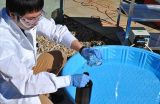(Press-News.org) Following a doubling of the incidence and prevalence of diabetes in the U.S. from 1990-2008, new data suggest a plateauing of the rate between 2008 and 2012 for adults, however the incidence continued to increase in Hispanic and non-Hispanic black adults, according to a study in the September 24 issue of JAMA.
Although there has been an increase in the prevalence and incidence of diabetes in the United States in recent decades, no studies have systematically examined long-term, national trends of this disease, according to background information in the article.
Linda S. Geiss, M.A., of the Centers for Disease Control and Prevention, Atlanta, and colleagues analyzed 1980-2012 data for 664,969 adults ages 20 to 79 years from the National Health Interview Survey and determined the annual percentage change in rates of the prevalence and incidence of diagnosed diabetes (type 1 and type 2 combined).
During 1980-2012, the trends in age-adjusted prevalence of diagnosed diabetes in the overall population were similar to those for age-adjusted incidence. The prevalence per 100 persons was 3.5 in 1990, 7.9 in 2008, and 8.3 in 2012. The incidence per 1,000 persons was 3.2 in 1990, 8.8 in 2008, and 7.1 in 2012. Both prevalence and incidence increased sharply during 1990-2008 (for prevalence, 4.5 percent, for incidence, 4.7 percent) before leveling off with no significant change during 2008-2012 (for prevalence, 0.6 percent, for incidence, -5-4 percent).
The researchers speculate that reasons for the potential slowing of the increase in diabetes may include a slowing in the rate of obesity, a major risk factor for type 2 diabetes.
Incidence and prevalence of diabetes ceased growing or leveled off in many population subgroups. However, incidence continued to increase in Hispanic and non-Hispanic black adults and prevalence continued to grow among those with a high school education or less. "This threatens to exacerbate racial/ethnic and socioeconomic disparities in diabetes prevalence and incidence. Furthermore, in light of the well-known excess risk of amputation, blindness, end-stage renal disease, disability, mortality, and health care costs associated with diabetes, the doubling of diabetes incidence and prevalence ensures that diabetes will remain a major public health problem that demands effective prevention and management programs," the authors write.INFORMATION:
(doi:10.1001/jama.2014.11494; Available pre-embargo to the media at http://media.jamanetwork.com)
Editor's Note: Please see the article for additional information, including other authors, author contributions and affiliations, financial disclosures, funding and support, etc.
Rate of diabetes in US may be leveling off
Although increase in prevalence continues for certain subgroups
2014-09-23
ELSE PRESS RELEASES FROM THIS DATE:
Effect of intervention, removal of costs, on prenatal genetic testing
2014-09-23
An intervention for pregnant women that included a computerized, interactive decision-support guide regarding prenatal genetic testing, and no cost for testing, resulted in less prenatal test use and more informed choices, according to a study in the September 24 issue of JAMA.
Since the introduction of amniocentesis, prenatal genetic testing guidelines have focused on identifying women at increased risk of giving birth to an infant with Down syndrome or other chromosomal abnormalities, for whom invasive diagnostic testing should be recommended. Prenatal genetic testing ...
Lung cancer test less effective in areas where infectious lung disease is more common
2014-09-23
An analysis of 70 studies finds that use of the diagnostic imaging procedure of fludeoxyglucose F18 (FDG)-positron emission tomography (PET) combined with computed tomography (CT) may not reliably distinguish benign disease from lung cancer in populations with endemic (high prevalence) infectious lung disease compared with nonendemic regions, according to a study in the September 24 issue of JAMA.
Depending on the risk for cancer, diagnostic guidelines suggest or recommend FDG combined with PET as a noninvasive test to assess the risk of cancer or benign disease, according ...
Study questions accuracy of lung cancer screens in some geographic regions
2014-09-23
A new analysis of published studies found that FDG-PET technology is less accurate in diagnosing lung cancer versus benign disease in regions where infections like histoplasmosis or tuberculosis are common. Misdiagnosis of lung lesions suspicious for cancer could lead to unnecessary tests and surgeries for patients, with additional potential complications and mortality.
Histoplasmosis and other fungal diseases are linked to fungi that are often concentrated in bird droppings and are found in soils.
The study by investigators at Vanderbilt University and the Tennessee ...
Asteroid named for University of Utah makes public debut
2014-09-23
SALT LAKE CITY, Sept. 23, 2014 – What's rocky, about a mile wide, orbits between Mars and Jupiter and poses no threat to Earth?
An asteroid named "Univofutah" after the University of Utah.
Discovered on Sept. 8, 2008, by longtime Utah astronomy educator Patrick Wiggins, the asteroid also known as 391795 (2008 RV77) this month was renamed Univofutah by the International Astronomical Union's Minor Planet Center in Cambridge, Massachusetts.
"It's neat," Wiggins says. "There aren't too many other universities on the whole planet with asteroids named after them. So that ...
Does size matter? MRI imaging sheds light on athletes most at risk for severe knee injury
2014-09-23
The successful rise and fall of an athlete's moving body relies on an orchestrated response of bones, joints, ligaments and tendons, putting the many angles and intersecting planes – literally the geometry – of a critical part like a knee joint to the test. But it's more than just a footfall error at the root of one of the most devastating of sports injuries: the ACL or anterior cruciate ligament tear. In fact, size – of the femoral notch that sits at the center of the knee joint – and volume of the ACL combine to influence the risk of suffering a noncontact ACL injury. ...
Infant cooing, babbling linked to hearing ability, MU researcher finds
2014-09-23
COLUMBIA, Mo. – Infants' vocalizations throughout the first year follow a set of predictable steps from crying and cooing to forming syllables and first words. However, previous research had not addressed how the amount of vocalizations may differ between hearing and deaf infants. Now, University of Missouri research shows that infant vocalizations are primarily motivated by infants' ability to hear their own babbling. Additionally, infants with profound hearing loss who received cochlear implants to help correct their hearing soon reached the vocalization levels of their ...
Solar energy-driven process could revolutionize oil sands tailings reclamation
2014-09-23
Edmonton—Cleaning up oil sands tailings has just gotten a lot greener thanks to a novel technique developed by University of Alberta civil engineering professors that uses solar energy to accelerate tailings pond reclamation efforts by industry.
Instead of using UV lamps as a light source to treat oil sands process affected water (OSPW) retained in tailings ponds, professors Mohamed Gamal El-Din and James Bolton have found that using the sunlight as a renewable energy source treats the wastewater just as efficiently but at a much lower cost.
"We know it works, so now ...
Antifreeze proteins in Antarctic fish prevent both freezing and melting
2014-09-23
Antarctic fish that manufacture their own "antifreeze" proteins to survive in the icy Southern Ocean also suffer an unfortunate side effect, researchers funded by the National Science Foundation (NSF) report: The protein-bound ice crystals that accumulate inside their bodies resist melting even when temperatures warm.
"We discovered what appears to be an undesirable consequence of the evolution of antifreeze proteins in Antarctic notothenioid fish," said University of Oregon doctoral student Paul Cziko, who led the research with University of Illinois animal biology ...
NYU-Mount Sinai Beth Israel study explores drug users' opinions on genetic testing
2014-09-23
Genomic medicine is rapidly developing, bringing with its advances promises of individualized genetic information to tailor and optimize prevention and treatment interventions. Genetic tests are already guiding treatments of the human immunodeficiency virus (HIV) and hepatitis c virus (HPC), and emerging research is showing genetic variants may be used to screen for an individual's susceptibility to addiction to a substance, and even inform treatments for addiction.
While there appear to be many benefits inherent in the development of this field and related research, ...
Slight alterations in microRNA sequences hold more information than previously thought
2014-09-23
(PHILADELPHIA) – Researchers have encountered variants or isoforms in microRNAs (miRNAs) before, but assumed that these variants were accidental byproducts. A recent study, published in the journal Oncotarget this month, shows that certain so called isomiRs have abundances that depend on geographic subpopulations and gender and that the most prevalent variant of a given miRNA may not be the one typically listed in the public databases.
"This study shows that microRNA isoforms are much more common than we had previously assumed. The fact that some isoforms are shared by ...
LAST 30 PRESS RELEASES:
Tracing the quick synthesis of an industrially important catalyst
New software sheds light on cancer’s hidden genetic networks
UT Health San Antonio awarded $3 million in CPRIT grants to bolster cancer research and prevention efforts in South Texas
Third symposium spotlights global challenge of new contaminants in China’s fight against pollution
From straw to soil harmony: International team reveals how biochar supercharges carbon-smart farming
Myeloma: How AI is redrawing the map of cancer care
Manhattan E. Charurat, Ph.D., MHS invested as the Homer and Martha Gudelsky Distinguished Professor in Medicine at the University of Maryland School of Medicine
Insilico Medicine’s Pharma.AI Q4 Winter Launch Recap: Revolutionizing drug discovery with cutting-edge AI innovations, accelerating the path to pharmaceutical superintelligence
Nanoplastics have diet-dependent impacts on digestive system health
Brain neuron death occurs throughout life and increases with age, a natural human protein drug may halt neuron death in Alzheimer’s disease
SPIE and CLP announce the recipients of the 2025 Advanced Photonics Young Innovator Award
Lessons from the Caldor Fire’s Christmas Valley ‘Miracle’
Ant societies rose by trading individual protection for collective power
Research reveals how ancient viral DNA shapes early embryonic development
A molecular gatekeeper that controls protein synthesis
New ‘cloaking device’ concept to shield sensitive tech from magnetic fields
Researchers show impact of mountain building and climate change on alpine biodiversity
Study models the transition from Neanderthals to modern humans in Europe
University of Phoenix College of Doctoral Studies releases white paper on AI-driven skilling to reduce burnout and restore worker autonomy
AIs fail at the game of visual “telephone”
The levers for a sustainable food system
Potential changes in US homelessness by ending federal support for housing first programs
Vulnerability of large language models to prompt injection when providing medical advice
Researchers develop new system for high-energy-density, long-life, multi-electron transfer bromine-based flow batteries
Ending federal support for housing first programs could increase U.S. homelessness by 5% in one year, new JAMA study finds
New research uncovers molecular ‘safety switch’ shielding cancers from immune attack
Bacteria resisting viral infection can still sink carbon to ocean floor
Younger biological age may increase depression risk in older women during COVID-19
Bharat Innovates 2026 National Basecamp Showcases India’s Most Promising Deep-Tech Ventures
Here’s what determines whether your income level rises or falls
[Press-News.org] Rate of diabetes in US may be leveling offAlthough increase in prevalence continues for certain subgroups


